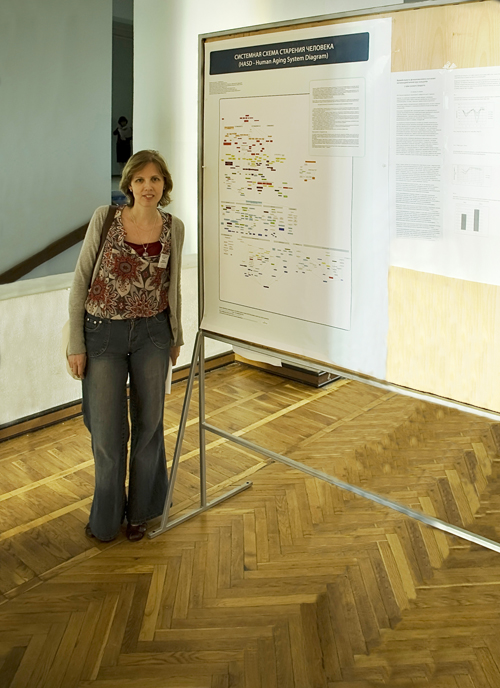- Russian
- English
- Français
Presentation about HASD in Kharkiv
The Human Aging System Diagram (HASD)
Project coordinator: 1.2 D.A. Medvedev
Scientific project coordinator: 3A.V. Krementsova
Academic advisers: 4A.A. Moskalev, 5B.A. Kaurov, 6I.V. Artyukhov, 3МV.B.Mamayev
1International Research Center of Advanced Technologies (Moscow, Russia)
2 “Science for Life Extension” Foundation (Moscow, Russia)
3Institute of Biochemical Physics named after N.M. Emmmanuel (Moscow, Russia)
4Komi Institute of Biology of the Ural Region Academy of Science (Syktyvkar, the Komi Republic, Russia)
5 Roszdrav Russian Gerontological Research and Clinical Center (Moscow, Russia)
6Institute of Aging Biology (Moscow, Russia)

Aging is a process of gradual depression of organism functions progressing in time and leading to increased probability of organism death with advancing age. In this project we have focused our attention exactly on the description of process, more exactly, of the totality of interelated processes of human aging. It is evident that any process, including human aging, can be depicted in a variety of ways: for example, by the description of changes in the metabolic pathways map or by the description of age-related dynamics of aging biological markers.
At present, there already exists the aging diagram developed by John D. Furber. This diagran depicts movements and transformation of metabolites related to aging in some way or other. Besides, it reflects the accumulation of harmful toxins, such as lipofuscin or ROS. In other words, this diagram puts major emphasis exactly on cell damage. There are both arrows of substance transfer and arrows of cause-and-effect relations.
In our project aging is described as a complex of processes starting from the prime causes (top) – (the natural processes that underlie aging), through disturbances in normal cell functioning, decrease of various physiological tissues and organs parameters to age-related pathologies and death (bottom). Thus, our aging diagram is both a system and process diagram. Its basic elements are various age-related processes. Constant general processes, such as digestion are not included, while specific processes such as "disruption in production of the gastric juice" can be included (since this process is related to change and is limited in time). The elements are connected with causal links
It should be mentioned that our Diagram describes exactly the human aging process, so we have not included processes characteristic of other biological species.
At present there does not exist any unified aging theory. In the given project we have made an attempt to consolidate all so far known aging mechanisms from molecular to organism level.
Aging is a complicated process comprising a variety of both positive and negative inverse relations. These relations are realized, in particular, through protective systems, for example, through antioxidant and reparation systems. Certainly, protective systems reduce aging processes intensity but are not able to cancel it. In other words, reparative systems essentially modulate process intensity and not its presence. Accordingly, we have excluded reparative systems from the Diagram.
In the Diagram development we adhered to the hierarchy principle. In the result we have distinguished 15 large blocks: GENETICS, STRESS, STRESS-INDUCED INITIAL CHANGES
IN PROTEINS, LIPIDES AND DNA, MITOSIS TERMINATION, CELLS DISORDERS FACTORS, INFORMATION AND MORPHOLOGICAL CELLS DAMAGE, CELLS CAPACITY REDUCTION, HYPERPLASIA, HYPERTROPHY, CELLS DISTROPHIA, ONCOLOGY, TISSUE AND ORGANS CAPACITY REDUCTION, DEGENERATION, PATHOLOGY, AGING SYMPTOMS NOT CAUSING LETHAL PATHOLOGIES AND DEATH.
The largest of these blocks are stress-induced initial changes and tissues and organs capacity reduction. These two blocks are subdiveded into several subblocks. Stres-induced initial changes comprise changes in DNA, proteins and lipides. In the tissues capacity reduction block individual tissues and tissue systems are distinguished, such as cardiovascular system, pulmonary system, supporting-motor system, etc. Thus, on the one hand, we have sought to reflect age-related universal processes, and, on the other hand, to consider various organs peculiarities.
Each of these larger blocks is composed of minor blocks desribing a particular process in detail. So far we have distinguished over 400 “microblocks” connected among themselves both by vertical (different organization levels) and horizontal links.
The hierarchy principle of the Diagram construction makes it possible to provide cognitive ease of visual perception of this complicated process. We consider that this approach will not onle ensure better understanding of interconnections among various processes, but will facilitate joint work of scientists from various fields in analysis and discussion of aging.
Actually, at present gerontology and allied sciences have accumulated immense knowledge and data bases on aging processes and there exist hundreds of hypotheses of aging nature and mechanisms. That is why the existence of a synthesis project consolodating this knowledge is a natural further development of aging science. It should be mentioned that scientific thought in all fields is increasingly using visual languages for the solution of complex problems, as text information presentation already imposes limitations on scientific inquiry.
Moreover, we intend to build a dynamic aging model which might generate new knowledge. The development of such a diagram will not only reveal perpective areas of anti-aging efforts, but will also allow to assess possible side effects of such interventions, as the Diagram demonstrates not just a individual aging process but all basic aging processes known to science.
At cellular level, aging represents an integral combination of disturbances of cellular and intercellular self-regulation processes, accumulation of own metabolic damage and shifts in neurohumoral regulation.
| Attachment | Size |
|---|---|
| 273.52 KB |



